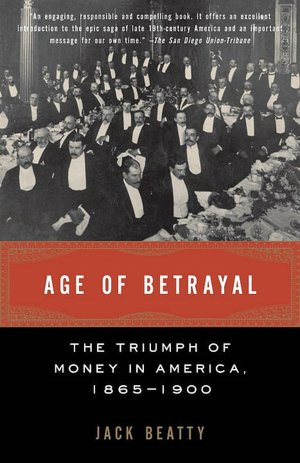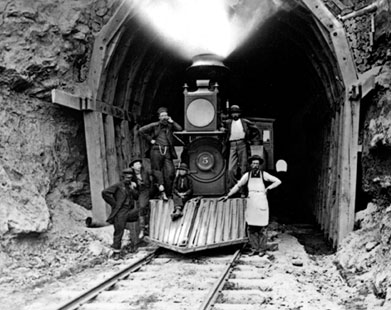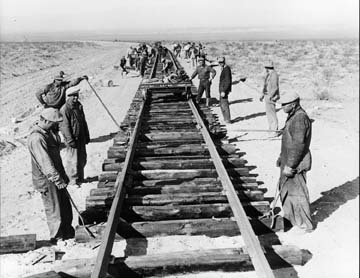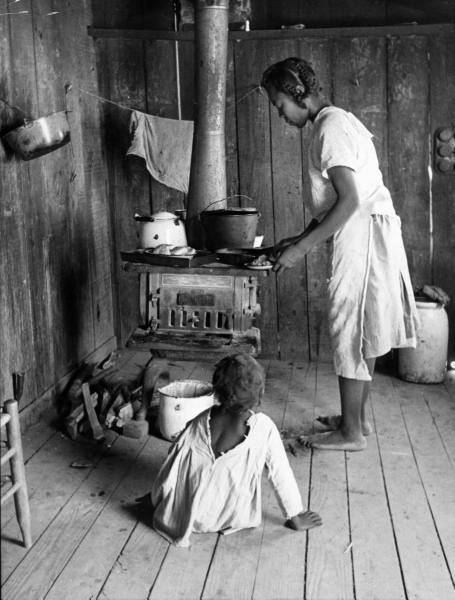
An interview with author Jack Beatty in the Atlantic: Why the title Age of Betrayal? Who—or what—exactly was betrayed?
I deal with three betrayals: of democracy, of the freed people of the South, and of what Lincoln called "the right to rise."
Government for the people, a despairing Rutherford B. Hayes noted in his diary, was supplanted in the Gilded Age by "government of the corporation, by the corporation, and for the corporation." It was an era when government held the keys to corporate and private fortunes—land and subsidies for railroads, tariff protection for manufacturers, mountains for mining companies, timber lands for lumber kings, court orders to prevent strikes, and state militia and federal lawmen and U.S. Army regulars to break strikes and shoot strikers. "Government by campaign contributions," in Henry Demarest Lloyd’s words, gave America the most violent strikes in the industrializing world.

Fifteen years after emancipation, the party of Lincoln betrayed the nearly four million former slaves in the South. Following the tied Hayes-Tilden election of 1876, the Republicans kept the presidency in return for ending Reconstruction. And the Lincoln-appointed justices of the Supreme Court effectively gelded the protections for the freed people that Congress had written into the Fourteenth Amendment. Instead of using the amendment as Congress intended—to strike down state laws abridging the rights of southern blacks—the court granted those protections to corporations, using the due-process clause of the amendment to strike down regulatory and labor laws.
For Lincoln, the small proprietor represented the American future. Lincoln’s model of mobility went like this: A penniless laborer takes a job on a farm or in a shop, works for a while, "puts by" a little money. Pretty soon, taking advantage of the Homestead Act, he sets up a small farm in the West or opens his own shop. In time he hires another penniless laborer, who follows the same path up. The Civil War was fought in no small part to defend this "free labor" system against the threat to it posed not only by slave labor but by wage labor, which Lincoln and his party saw as inconsistent with the American idea of freedom. To them, freedom meant economic independence. The vision was that war would break the fetters of caste and class that denied men "the right to rise." So free labor and slave labor fought, but it was wage labor—industrial capitalism—that won. In a common image of the time, the ladders leading up were kicked away.

Well, that’s the argument. Even when Lincoln was advocating free labor, it was a nostalgic idea. As early as 1866, 60 percent of people worked for other people. Now, it’s 90-something percent. Then, of course, they worked in small units; it wasn’t the full-blown factory. But sure, Lincoln’s vision was at variance with the imperatives of the economy and with the necessities of the industrializing elites who came to power after the war. And then there was the railroad—and that changed everything.

What was the role of the railroad? People tend to think that the main change the railroad wrought was quicker travel. But you talk about it being much more transformative than that.
Before the railroad, America’s industrialization was hostage to America’s geography. As late as 1839 it took four days for goods to travel the 60 miles between Lowell and Concord, New Hampshire. In 1841, the railroad cut that to four hours. Four days to four hours in four years—vertiginous change. In a verb favored by railroad promoters, the railroad "annihilated" American space. Before, the railroad factories could not maintain continuous production for want of continuous supply of raw materials—floods washed out roads, ice shut down lakes, rivers, and canals. After the railroad, factories could run around the clock and goods could reach customers previously lost to distance.

And the goods were more affordable thanks to scale-and-scope production. In the words of the late Alfred D. Chandler, the dean of business history, scale and scope constitute "the dynamics of industrial capitalism." They make it go. Everything depends on them. By making more of something, you can make and sell it cheaper—that’s economy of scale. And from the same processes of production used to make one thing, you can make another—that’s economy of scope. The railroad, in Emerson’s phrase, was the "magician’s wand" that released scale and scope, and transformed America from a commercial-agrarian nation into the world’s leading industrial power in fifty years.

But the dynamics of industrial capitalism destroyed the viability of the free-labor dream. In the book I instance an Akron, Ohio, butcher. He fits Lincoln’s ideal: a small proprietor who slaughters local beef. Then one day Armour, a pioneer in scale-and-scope production at its Chicago meatpacking plant, drives a refrigerated car into Akron, and holds a sale in the railroad yards, underselling the Akron butcher by a factor of magnitude. He can’t compete. Scale and scope have put him out of business. If he takes a job at Armour’s slaughter-house, he moves down the class and opportunity scale from free labor to wage labor. He can still rise—but within the working class and only through collective bargaining. But for that he’s got to wait until the New Deal and the rising tide of the postwar boom. Cheated expectations fed the violent strikes of the era, including the largest strike anywhere in the world in the 19th century, the Great Railroad Strike of 1877, which I chronicle in the book.

Scale and scope transformed not only manufacturing but farming. Mechanization brought continuous production to agriculture, and the railroad connected the farmer to the city and to the world market. Returns went to scale—to bigger and bigger farms. Lincoln’s farm laborer could not "put enough by" to buy his own farm—everywhere the railroad bid up the price of land. He could not rise. He stayed a farm laborer—or quit the farm for the city.

Still, the free-labor ideal survives in farming as propaganda. Preserving the tiny number of "family farms" is a justification put forward by the farm lobby. The Homestead Act was put forth by the Republicans as a supposed cure for the class structure congealed by industrialism. The idea was that the eastern factory laborer would leave the factory behind for free land in the west. But that’s not the way it worked out. Why? Because the land was not free—$1,500 was the minimum needed to set up a farm as early as the 1840s. And that was three years pay for the skilled factory worker of 1900! Small farms weren't economically viable. So it wasn’t the factory laborer who went to the farm, but the factory itself. Women’s labor, child labor, seasonal labor—all the aspects of wage labor that the farm was supposed to cure became a part of farm life. That was a bitter social turn. There was no escape from industrial capitalism.

That’s interesting, because particularly with farming, these are issues that we’re still working through today—the small farmer versus the big farmer and buying local.
That’s right. Some environmentally conscious people are trying to uncouple us from the industrial umbilical. The environmentalist Bill McKibben is pushing a movement to cut the carbon tail of trucked-in food. He advocates abandoning the, as he sees it, false economies of scale and scope—false because they don’t include the environmental costs of production and transportation. He thinks it’s a doable step toward saving the biosphere from global warming. One problem with buying local, though, is choice—winter salads suffer. Another is price. The Wal-Mart shopper can’t afford to buy local. He depends on scale and scope production in agribusiness to keep food prices low.

One of the things I think is unusual about your writing is that it blends history—which can be a dry pursuit—with real rhetorical spark and style. Could you talk about your writing process? How important is wordsmithing to you as you write? How would you describe your style?
History tends to be written—because of academic pressures—in a polished, professional monotone. I like a little more drama. At certain moments, intensification, foreshadowing, or dramatic juxtaposition. Also, you look for scenes, moments of action, that carry your theme: a racial massacre in Colfax, Louisiana, the gun battle between Pinkerton detectives and workers at Andrew Carnegie’s Homestead Mills. Little touches matter in a long book. Our late Atlantic colleague, Peter Davison, once told me that for a writer to use the verb "to be" is laziness. Ever since, I have tried to find better—livelier—verbs. I do not believe I use "very" or "astonishing" in the book—a record. I admit to using at least one "kind of" but no "sort of," an Englishman’s arch tic that has no place in American writing. And in general, though I love ’em, I pare away adjectives and adverbs. They’re for book reviewers, to display cleverness. Subject-verb-object—you can’t beat that formula in long-form narrative.
For drama, you also need representative characters. My characters include Tom Scott, president of the Pennsylvania Railroad, the largest corporation in the world in the 1870s, and a "political capitalist"—a purchaser of politicians retail and wholesale. Even in an era when, as Henry D. Lloyd wrote in The Atlantic, "Standard Oil did everything to the Pennsylvania legislature, except refine it," Scott stood out. It isn’t every captain of industry who could bargain the White House for a railroad land-grant as Scott did in 1877. Scott’s feckless attempt to drive John D. Rockefeller out of business helped to precipitate the railroad strike of 1877, with its bloody climax in the streets and alleys of Pittsburgh swept by Gatling guns.

This is a book that’s almost unremittingly dark—the bloody racial carnage of the Colfax Riot, the violent strikebreaking in Pittsburgh. Was it darker than you thought it would be when you set out to write it?
It’s one of the darkest chapters in American history. Betrayal is among the most embittering experiences in life. "You said you loved me, but…" "You promised me…" "I thought we had a deal…" "I thought I could trust you." We’ve all heard or said such things. I sought to infuse some of the emotion of such personal experiences into my account of the age.

Some reviewers have said, "My God, this is so gloomy! You didn’t pay attention to Alexander Graham Bell!" But I couldn’t write in a lighter key and still tell the truth. The "Gilded Age" —that rubric obscures the moral facts: betrayal of emancipation, betrayal of democracy, betrayal of free labor. The book ends with our imperialist grab-up of the Philippines, a betrayal of our revolutionary birthright.
You can’t exaggerate how bad it was for blacks in the South after Reconstruction—the systemic violation of human rights. John Lewis, the Georgia congressman and civil-rights hero, once said, "My daddy didn’t vote. My granddaddy couldn’t vote. My great-granddaddy couldn’t vote." It was democracy denied, equality before the law denied: that happened here. White Americans did that and tolerated that.

And up until the 1960s—it’s amazing how long it went on.
It would have gone on forever if Southern blacks hadn’t put their lives on the line to force the federal government—and shame the nation—into pressing ahead with a Second Reconstruction to complete the work of the first. And if a great leader—a Lincolnesque leader—a century after Gettysburg had not sounded the call for "a new birth of freedom."

Because it was the seed-time of today—government for the corporation—and I wanted to find out where we went wrong and why. In the textbooks and to a certain extent in American memory, this is the Age of Enterprise—of free-market capitalism, etcetera. Nothing could be further from the truth. I don’t like the official version of America spread by uplift historians who tell Americans what they want to hear. Good news history has weakened Americans’ critical faculties in the face of government and media propaganda. We’re living through a war that’s all about manipulation of public opinion—manipulating Americans’ hopes that their country is as good as the uplift maintains. Americans need less consolation from history and more truth, especially about juridical racism and the conflict between corporate power and democracy—my themes.

I think so. This year, a big biography of Carnegie was published. A couple of years ago, there was an 800-page biography of Morgan by Jean Strouse. In 1998, there was a big biography of Rockefeller. There was recently a big biography of Henry Ford—seemingly the 900th biography. A biography of Andrew Mellon was just published. Reviewers say, "This biography of Carnegie gives us the age." Would a biography of Bill Gates convey the essence of our age? I see these books and think, This can’t be it. This can’t be the only face of the Gilded Age Americans get to see. So I wrote the book to show a more representative face, to retell what usually is told as an economic story as a moral one.

During this era, New York Governor Roswell P. Flower commented, "In America, the people support the government. It is not the province of the government to support the people." These days, not even a conservative Republican could get away with saying that. Could you talk about how the expectations for the government have changed since the Gilded Age?
Maximalist government for the corporations and minimalist government for the people—that was the rule in the age of betrayal. The leader who changed that was William Jennings Bryan, the Democratic presidential nominee in 1896, and, at thirty-six, the youngest ever. Breaking with the sterile anti-statism of his party, Bryan said that government should be active on behalf of the people. That’s the turn in the Democratic party. Essentially, Wilson, FDR, Truman, and the rest followed where Bryan led. Government should act to protect the people against private power, through anti-trust. It should act with old-age pensions, and with workers’ compensation, and the like. Bryan is often rendered as a backward-looking pastoralist. But in fact, he began modern politics, because he introduced the populist impulse into the Democratic party—the idea that government should support the people. It was always something that Southern Democrats were uncomfortable with, because they saw where it led. Government would start acting for the black people, as it eventually did.

The strong parallels between the Gilded Age and today are an undercurrent of the book. Could you talk about some of those parallels?
The main parallel is the role of organized money in politics and how that increases the other parallel with the Gilded Age: inequality. In 2008 we’ll see the first billion-dollar presidential campaign—between them, the two presidential nominees will raise and spend a billion dollars. Money is speech, and the next president will listen to the money that has bought them the White House.
Complacent observers say, "At worst money gains access. It doesn’t determine votes." Tell that to Hillary Clinton. When she was first lady, Congress passed and her husband looked set to sign a bankruptcy "reform" bill. But Elizabeth Warren, a young Harvard law professor and a student of bankruptcy proceedings, persuaded Hillary the "reform" would hurt people who lose their health insurance and can’t pay the bills for catastrophic medical care. Hillary lobbied Bill. He vetoed the bill. The same bill came before Congress after Hillary was elected senator from New York. She voted for it. Same bill, same harm to the vulnerable Americans she professes to care about. What changed her mind? She got $150,000 in campaign contributions from the credit card industry. Case closed on whether money buys votes. Meanwhile, the people who change the bedpans and sweep the floors—their voices aren’t heard.

And what about the concentration of wealth? Are we back to where we were during the Gilded Age?
The concentration of wealth is not quite at the Gilded Age chasm, but we’re getting there. Back then Americans could not imagine a fairer society; inequality was continuous with the unequal past. Today we can remember a fairer past—the New Deal era from the 1940s to 1970 saw real family incomes double, high marginal tax rates on the rich, and unions representing more than a third of the private-sector workforce. Memory is a radical organ in today’s America. Between 1950 and 1970 for every additional dollar earned by the bottom 90 percent of the income distribution, the top .01 percent earned $162. Today, the top .01 percent earn $18,000. Gilded Age Americans lived before equality. We live after equality. Outrage over business rule and the un-American concentration of wealth and power spurred the early twentieth-century reform movement known as Progressivism. Corporate contributions to political campaigns were outlawed. Monopolies were broken up. Progressive income and inheritance taxes were passed. Will history repeat itself? The Gilded Age has repeated itself; why not the Progressive Era? That should be the question decided by the 2008 election. (source: Atlantic)

No comments:
Post a Comment